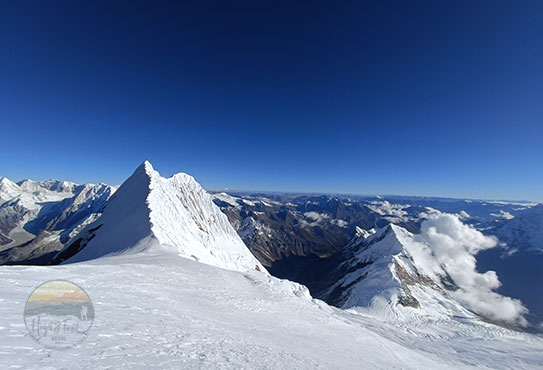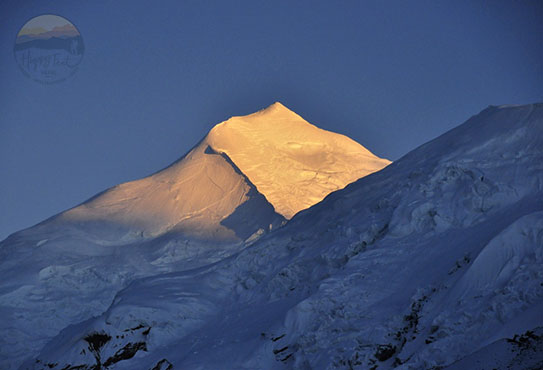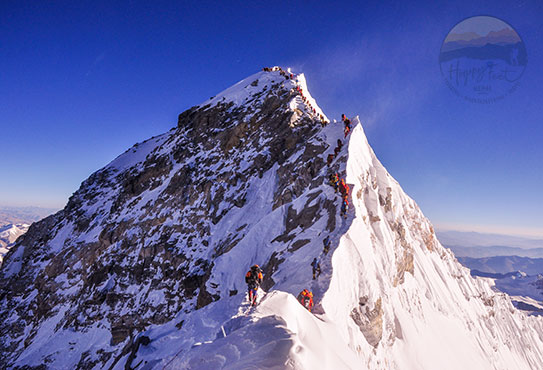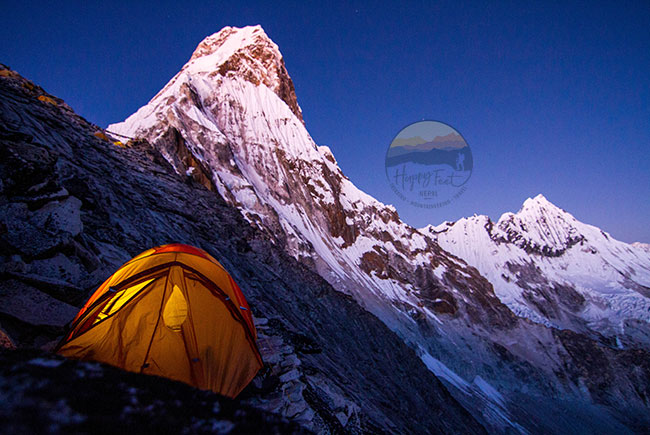-
Sunday - Friday: 9 AM - 4 PM
Everest Climbing Itinerary depends on the program set by each Everest expedition group and their aim. The Everest Climbing itinerary presented here is the base of the general itinerary. Still, as the Expedition group start climbing from Everest base camp, each climbing pair or group resets their own itinerary as they complete the acclimatizing climbing rotation.
Mount Everest, the Third Pole, is the highest of all 14 loftiest peaks above 8,000 metres. The mountain and its influential area are important for its height and beauty and its ecological source. Everest and its range accumulate one of the largest snows and ice, continuously feeding numerous major rivers, benefitting billions of people and natural habitats in South Asia. The highest mountain in the world was brought out to the broader public concern by Sir George Everest, the Surveyor General of India, from 1830 to 1843.
The official name “Everest” was given in 1965. Everest is Sagarmatha in Nepali and Chomolungma in Tibetan/Sherpa/Rai. The name Sagarmatha (Head/Forehead in the sky) was given by a Nepalese historian, Baburam Acharya (1888-1971), in 1955. The name Chomolungma (Goddess Mother of Mountains) in Tibetan, Sherpa and Limbu/Rai is believed to exist long before Everest and Sagarmatha, but no specific record exists. The Mount Dhaulagiri and Mount Kanchenjunga mountains were the first and second to be claimed as the world’s tallest mountains before Everest was recognized. The summit of Everest also marks the international border between Nepal and Tibet. Tenzing Norgay Sherpa of Nepal and Sir Edmund Hillary of New Zealand are the first humans to conquer the mountain, and numerous men and women later on. Most climbers who succeeded in achieving Everest’s summit lived and are living glorified in the world. The feat is taken as one of the lifetime achievements.
Arrive in Kathmandu, customs and immigration formalities and claim your baggage, which takes some time. Upon exiting, the arrivals get a traditional welcome from the Happy Feet Mountaineers representative and transfer to the hotel. Reach the hotel, and the rest of the day is free with the possibility of optional excursions (not included), but you can ask to organize any tours or stroll through its vibrant streets.
Kathmandu, the capital and heart of the country, with three medieval cities, symbolizes Nepal’s everything. Having lived through the several ruling dynasties of Buddhists and Hindus, the culture and society of Kathmandu Valley have evolved through time to give it more than a unique feature. Today it is an urban city, and still rapidly increasing, that has its ancient myths and, at the same time, is testimony to the greatness of people who have lived there for time immemorial.
A completely free day to do last-minute shopping and repacking the bags to basecamp properly. This evening you must hand over your bags to Basecamp for cargo to Lukla and then by porter to the Everest Basecamp. The mountaineering team leader will need to go to the Department of the Ministry of Tourism to sign the document related to the mountaineering permit and responsibilities.
A 30-minute flight and a 3-hour trek.
Breakfast and take a short drive to Kathmandu Airport to board the domestic flight to Lukla. A morning flight of 40 minutes takes us to Lukla, with grand views of Himalayan peaks. We will be greeted with an excellent mountain in the panorama from the first step to the Lukla airport, with cool air letting you feel the atmosphere. We spend about an hour with tea/coffee and handover our luggage to the porters. Then, we take a short introductory walk while the porters prepare their load. After spending an hour, we start the trek with great excitement.
Star trek through the village of Lukla, gets checked with Khumbu Pasang Lhamu and TIMS permits at the end of the town and exits from the village with immediate walking down through a forest facing northwest with welcoming views of Mount Kongde (Dudh Kunda Mountains) in front. After about twenty minutes walk, the trail traverses to Chhoplung, seeing the village and School of Chauri Kharka (currently misspelt with Chaula Kharka). (Chauri is female Yak, and Kharka means Shed in Nepali), the largest and ancestral village of Lukla village until Lukla Airport was pastureland. After a short traverse, we join the trail from Jiri to Everest Basecamp at Chhoplung, a hamlet of Sherpas. From Chhoplung, there is a level trail with short descending and climbing and traverses several villages, including Ghat. The views in front are Phakdingma, the Dudh Kosi River Valley and Kongde Mountain. Most houses on the trail and villages are lodges and restaurants for travellers. Finally, we cross several beautiful villages, such as Ghat and arrive at Kharikhola village on the bank of the Dudh Kohsi River.
A 5-hour Trek.
The trek follows the Dudh Kosi River valley through a narrow valley gorged by the Dudh Kosi River and guarded by Kusumkangru Mountain and Kongde Mountain bases. The river valley becomes narrower but a pleasant walk with occasional mountain views and teahouse until we approach Monjo, the entrance point of Sagarmatha National Park and our lunch place, a lovely place on the bank of Dudh Kosi River. The high mountain slopes are beautifully dense, home to elusive Himalayan fauna and flora.
The afternoon walk takes uphill to Namche Bazaar through a lovely forest, crossing the Dudh Kosi twice through a sky-soaring suspension bridge. The walking up to Namche takes 2 hours with rest.
Namche Bazar lies at an altitude of 3500 metres, and it is one of the main junctions, branching trails to Thame, Khumjung and Tengboche. The path via Thame leads to Tibet via Nangpa La Pass, Rolwaling via Tashi Lapcha Pass, and Gokyo via Renjo La. With the demand of the time, the Sherpa town has developed itself as a colourful and divergent market, selling everything, including trekking and mountaineering equipment. In addition, there are hotels, restaurants, pubs, cybercafé, pool houses, Banks, health posts, a monastery, and a Sherpa house museum. Most trekkers take a day’s rest at Namche while hiking up and lunch or refreshment while returning. Those taking a rest at Namche can take a hike to Thamo village on the way to Thame or stroll at Everest View Hotel, an over graded five-star hotel above Namche with fantastic views of Everest and its surroundings.
After breakfast, we make a scenic Namche to Khumjung trek. The trail leads through the Shayngboche airstrip, a short landing field for the Pilatus Porter plane. Instead of going directly to Khumjung, we take the trail via Everest View, a 5-star hotel, enjoying the 360-degree panorama surrounding the Khumbu region. Probably lunch at Everest View Hotel and take a leisurely descent to Khumjung. If we go to Khumjung for Lunch, we visit Khunde village and its monastery.
A 4-hour Trek.
A scenic trail exits northeast of Khumjung, gradually descending and reaching a trail junction branching to Gokyo, Namche, Khumjung and Tengboche. We take the trail to Tengboche, traversing a hill ridge. The Dudh Kosi valley, Thamserku, Kusum Kangru, Ama Dablam, Lhotse, Nuptse, Everest, Tawoche, Khumbila and Kongde are some of the highlights of the day. The area from Namche to Tengboche and Phortse is home to the Himalayan tahr, standing on the sheer cliff tops and hill slopes with luxurious manes and rainbowy impean pheasants, the national bird of Nepal, and skittery Musk Deer. We take the trail to the Everest base camp and head toward the Phortse Tenga with a pleasant descent, where we take our lunch below the Phortse and Tengboche villages.
The afternoon requires uphill till Tengboche through a forest full of rhododendron, pine and birch. While resting, the views toward Namche with Kongde, Everest view hotel, Mongla, Kangthega, Kusumkangru, Dudh Koshi Valley, and Khumbila are beautifully open. With the first step on the Tengboche meadow, the views to the north are unobstructed, with an imposing Mount Ama Dablam, Lhotse, and Nuptse topped by the tip of Mount Everest. Tengboche is a beautiful place in terms of its views. Get checked into the rooms and refreshments, and visit the Tengboche Monastery.
Tengboche Monastery is one of the most known monasteries in Nepal, probably because of its unrivalled backdrop of Mt. Ama Dablam. This monastery was the leading Buddhist centre in the Khumbu region under the guidance of Tengboche Rinpoche, who passed away on the 10th of October 2020. Another active monastery in the Khumbu region is the Thame Monastery. But among the most ancient are Pangboche Monastery, Thame Monastery and Rimijung Monastery, founded by Lama Sangwa Dorjee and his two tantric brothers.
A 6-hour trek.
The morning starts with grand views in front. The first part of the trek leads downhill through the lovely rhododendron and pine forest to Diboche, with several lodges and a monastery of nuns; those interested may visit the monastery. Continuing a level walk through a pleasant and primitive-looking forest brings us below the Pangboche village. Next, we cross the bridge and go uphill to Pangboche with a majestic view of Ama Dablam; the base camp of Ama Dablam is barely within two hours of easy walking distance.
The ancient original settlement is above the main trail to Everest Base Camp amidst tall Himalayan juniper trees. We shortly climb the village and visit the Pangboche village, one of the ancient villages of Khumbu Valley with a monastery. Amongst the three most ancient monasteries in Khumbu Valley are Pangboche Monastery, Thame Monastery and Rimijung Monastery, founded by Lama Sangwa Dorjee and his two tantric brothers. We stop here for lunch, visit the monastery, solicit a puja ritual, and pray for an obstacle-free expedition.
The afternoon starts on a level trail following the river and views of Ama Dablam and Chhukung Valley. Finally, we cross a bridge over a stream that flows from the Khumbu glacier below Pheriche, and after an easy walk to Dingboche, the last largest village in the Chhukung valley.
A 6-hour Trek.
A further acclimatizing day at Dingboche before entering the base of Everest to ensure nothing surprises our lifetime program. There are several options to spend the day, including a relaxing day at the lodge. The most recommended option is an excursion to Chhukung, the last inhabitable site below the sheer Lhotse and Nuptse wall. The trail to Chhukung and back are beautiful, with mani-walls and some sacred sites adorned with colourful prayer flags fluttering against the incredible views. If you make this trip, give some energy to summit the Chhukung Ri 5540 metres, and enjoy seeing the red granite of Makalu, the south wall of Baruntse, Ama Dablam; and in hand reaching distance, the sheer wall of Lhotse and Nuptse! Many of our guests say Chhukung Ri has the most beautiful views. Have lunch at Chhukung and return to Dingboche, one of the beautiful days. A short climb above the village offers gorgeous scenery of the complete Dingboche village with imposing Ama Dablam and your surroundings.
A 3-hour Trek.
The trek begins with a gentle uphill and traverses to Thugla, with beautiful views of Pheriche village and its valley expanding high above until the Dzongla with a beautiful view of Mount Tawoche, Cholhatse and Lobuje Peak. Lobuje is one of the most preferred six thousand metres acclimatizing peaks for most Everest climbers and a trekkers’ peak to experience climbing in the Himalayas while on a trek in the region. Then, cross the freshly exiting Khumbu glacial river, on a bridge, at Thugla and climb gradually up until the level of the Khumbu glacier rim. Looking back toward the lower valley while taking short rests offers incredible sceneries, yet 360-degree views, Everest hidden by the Nuptse.
The pace naturally gets slowed due to the less oxygen in the influence of the World’s highest mountain, but the distance from Dingboche to Lobuche is very short; for local Sherpas, it is a 40-minute walk!
Lobuche is the major stoppage for all trekkers and mountaineering groups to Everest. Most trekkers use Lobuche as a base for the Kalapathar viewpoint and make a day excursion to avoid the chances of altitude sickness, and Everest climbing groups come here to rest and recharge.
A 3-hour trek.
The trail leads through the rim of the Khumbu glacier, with fantastic views around. As we approach Gorakshep, Mount Pumori appear as beautiful and majestic as Mount Ama Dablam from Tengboche. At Gorakshep, we check into a Lodge, have lunch, and enjoy free time to stroll around. Optionally, in the afternoon, take a hike to the top of Kalapathar, one of the most famed viewpoints in the World, to catch the best views of Mount Everest. The trip takes about 45 minutes to reach the top of Kalapathar.
A 3-hour trek.
Today we hike to the top of Kalapathar, one of the most famed viewpoints in the World, to catch the best views of Mount Everest. The trip starts early at dawn to see Everest’s changing colours, black to yellow, gold and silver, with the first sunrise rays landing on top of Everest! The trip takes about 45 minutes, enjoying the glowing east, the sign that the sun is throwing its beam at any moment. Then, take great pictures and descend to Gorakshep for a hearty hot breakfast.
After breakfast, the walk continues east with great views of the Khumbu glacier and Everest base camp in front. The trail is primarily flat but requires walking on a glacial moraine. However, the sight of Mount Pumori and the Khumbu Icefall is attractive. We arrive at the base camp with warm, welcoming greetings from our staff, followed by Tea-coffee and juice. Get assigned to your tent and hand over your duffel bags with climbing gear—lunch and free.
The five days are spent with busy schedules, including health check-ups, puja Ceremonies, meetings, climbing equipment checking, ladder bridge walking, ladder climbing and descending, and hiking to Pumotri Kalapathar; to acclimatize and physical exercise. However, the Puja ceremony at the Everest Base Camp is prioritized, which allows the climbing Sherpa guide to start climbing camps two and three to deposit the expedition supplies. For the Puja, a monk from Pangboche or a nearby village will be invited for a puja ritual to solicit the local deities for a peaceful and obstacle-free expedition.
A 5-hour Trek.
Retrace to Gorakshep, Lobuche, and fork west to Lobuje Peak Base Camp. As we traverse to the Lobuje Peak base camp, the sceneries toward Lobuche and Dzongla are indescribable. The basecamp situates in a small valley opening to the south, which provides fantastic views and a warm place to Camp.
Lobuje Peak, 6,119 metres, is the second-most famous peak, climbed during an Everest Basecamp trek or in an Everest Acclimatizing climb. The usual route to the high Camp and summit goes up a small valley, continuing from the base camp. The mountain has two summits, East and West, with 6,145 and 6,090 metres; the west is an Expedition Peak. After the ascent, we directly descend to basecamp, where our kitchen crews will await us with some recharging hot items. Lobuje is an acclimatizing climb; therefore, the focus is to sleep at about 6000 meters and back.
Four complete rest days to recharge the body. A comfortable single room gets assigned to each member. A cook helper will descend to Lobuche to prepare special meals for the members while on rest camp to continue on Everest, and an open menu is always available to choose from members.
A two hours walk to Everest Basecamp. Meet and greet all staff and other members.
Rest, body check-ups, meet and brief, recheck the equipment list, and information on camps, communication, meals, oxygen, climbing guides, and time schedules.
Rest until 20:30 and start climbing to meet the Everest Summit between 7 a.m. and 11 a.m. and return to C4.
Farewell with the Sherpa guides and base camp staff and board a helicopter flight, 11:00 hours, to Lukla and then Kathmandu. Upon landing, the representative of Happy Feet Nepal will welcome you back and transfer you to your hotels. Get distributed to the rooms, and the rest of the day is free.
The expedition team leader must visit the tourism ministry to sign the related document. Other members are free to do their last-day activities. The evening gets dedicated to a farewell dinner in one of the celebrative restaurants of Kathmandu.
Breakfast and the rest of the day are leisure on your own. The Representative of Happy Feet Nepal will arrive at your hotel with transport three hours before your departure flight time. Get escorted from the hotel to the International Departure Terminal, see off formalities, and go through the immigration and departure.



